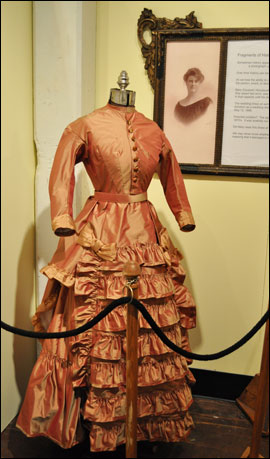
Finished replica gown on display: The replica gown was used in an exhibit, “Hidden Gems,” at the Willamette Heritage Center in Salem, Oregon. Behind the gown is a portrait of Mary Elizabeth Woodward Patterson, the original owner of the gown. Photo courtesy of Betty Murrell of Deepwood Estate.
The Patterson Wedding Dress is a one-piece, trimmed silk gown. Three main elements were sewn together: a bodice, skirt, and overskirt. The bodice is fully lined, darted, piped, and trimmed with decorative buttons and simple sleeve trims. The skirt is fully lined with hem reinforcement sewn inside the lining and a wool braid “hem saver” binding on the lower edge. The skirt front is trimmed with seven horizontal bands of self-fabric flounces on the center front gore, edged by a vertical flounce of the same material on each side, finished with decorative ribbon bows. The shaped overskirt starts at the front side seams and lengthens in the center back. It is trimmed with a border of a gathered contrast ribbon.
Historical context
This dress is typical of middle-class “best” gowns worn in the late 1860s and early 1870s. I have studied similar silk gowns of the era, one in the private collection of Judy Goldmann of Washington County, worn by her great-grandmother Guillerma Steward as a “second-day” dress for her marriage in 1869 in Missouri. The other similar dress I have examined was a black silk taffeta mourning dress in the collection of the Phillip Foster Farm in Estacada, Oregon. Both of these dresses had a similar construction method and remarkably similar configuration of the front bodice darts. The double darts are angled toward the center front at the waist much more than was typical only a few years earlier, before 1865. Both of the other two dresses featured the shaped two-part sleeve design and the separate skirt sewn to the bodice. However, the Patterson dress has the additional embellishment of a shaped overskirt, hinting at a slightly later date and the influence of the bustle style.
Fabrics and notions
The original gown is made of silk taffeta in a warm brownish color, trimmed with self fabric flounces and a contrast silk ribbon. This color, which we might call “acorn” or “toast”, was known as cuir, a French word for leather. It was a popular color at the time, mentioned regularly in Godey’s Lady’s Book frequently throughout the 1860s. The Patterson dress is lined in a light brown glazed cotton fabric. The bodice is boned in the front and at the side seams. The sleeves are finished with a self-fabric piping edge and a mock cuff of the ribbon. The armscyes are piped with the same narrow self-fabric piping.
The original silk fabric is severely damaged, breaking apart in a distinctive pattern known as “shattering.” This is due to a commercial finishing process of treating silk fabrics with metallic salts. In the short term, this produced lustrous, heavy fabrics which benefitted the manufacturers because silk fabric was sold by weight, not by the yard. However, the treatment also weakened the fibers, making them susceptible to breakage in this way. The lining, the same age as the dress, is still in remarkably good condition.
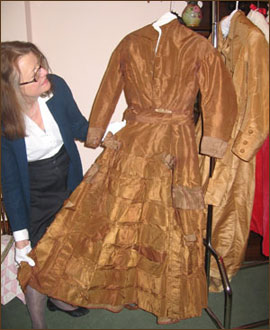
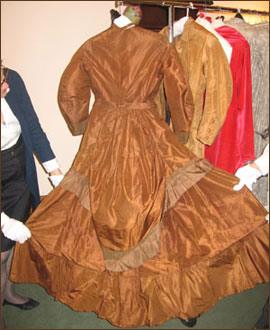
Design notes
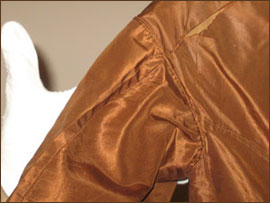
The bodice is very plain and slightly short-waisted. The sleeves are cut in the “coat sleeve” or two-part construction style. This was a common shape in the late 1860s and early 1870s, providing ample wearing ease while providing a smooth appearance when the hands were clasped in front. The bodice was constructed separately and completely finished at the waist edge with a piping facing.
The skirt itself is cut with a shaped center front gore, an angled side gore, and a large rectangular shaped center back section. The top of the skirt back is cartridge pleated, a traditional way to hand gather a large amount of fabric into a small space at the waist. It was widely used for most skirts in the 1840s, but it had become less common once pleating became fashionable in the 1860s. It was an appropriate way to give this skirt the correct fashionable shape—full in the back.
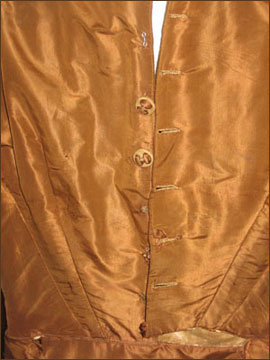
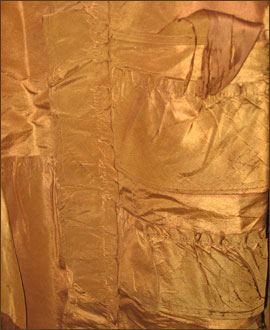
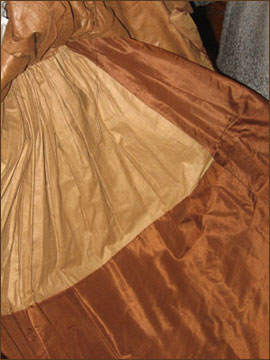
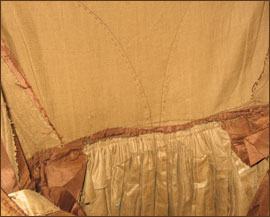
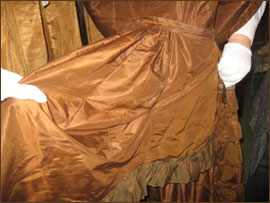
Construction notes
Some sections of the bodice were finished by machine. The bodice seams, the decorative fiddleback detail, and the waist where the skirt attached were all machine topstitched. Oddly, the long seams of the skirt lining were hand sewn. In addition, the flounces were attached by hand, even though other dresses from the same time period were completely assembled by sewing machine. (See attachment from Costume in Detail, Nancy Bradfield.) NOTE: I did not examine all the seams to determine the sewing methods used in the rest of the garment.
The top portion of the center back section is the lining only. Since the seamstress knew that the top of the skirt would always be covered by the attached overskirt, there was no need to use the expensive silk fabric in that section.
Notes on the replica gown
The replica gown is made from silk taffeta in an iridescent weave of red and yellow, resulting in a warm brown shade similar to the original. It is trimmed with silk ribbon in a solid gold color. The buttons used were vintage 20th century glass shank buttons in a similar size and shape to the originals. Since I was not able to find a source for replica brown glazed cotton for the lining, I used white cotton muslin in a medium weight.

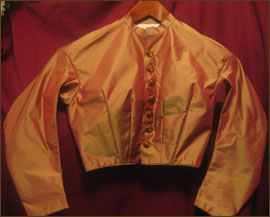
Using the cotton lining material as an interlining, I sewed to the fashion fabric at all the seams as was typically done in 19th century dresses. I pieced the overskirt and right sleeve is the same places where the original gown was pieced. Apparently the original fabric came in a narrow width, not the 45” width I was able to use, so piecing was an acceptable way to use the silk fabric efficiently.
I used 100% cotton thread throughout the replica project. I attached the flounces by hand to match the appearance of the original trimmings. The seven buttonholes are handmade and 7/8” long, just as they were in the original garment.
Photo credits: All images were taken by Kelly Demlow except as noted.
We can custom-make many other beautiful styles for you. Please contact us with your ideas!
